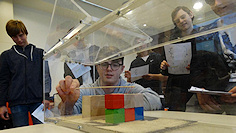Přijďte k nám ve dnech 12., 14. a 16. listopadu 2019, ať vidíte, na čem děláme! Více zde.

We kindly invite you to the lecture of Dr. Shan Zhong from the School of Mechanical, Aerospace and Civil Engineering, Manchester University, UK, entitled „Understanding the fluid mechanics of synthetic jets for flow separation control“. The lecture will take place in the Lecture Room A of the Institute of Thermomechanics ASCR on June 10, 2014 at 10:30.
Dr. Zhong is a Senior Lecturer at Department of Mechanical, Aerospace and Civil Engineering, Manchester University. Her research at Manchester is mainly concerned with shear flows. She is particularly interested in studying the fundamental physical mechanics of complex fluid phenomenon using experimental methods. She has been active in the research areas of boundary-layer laminar to turbulent transition, flow control and fluid mixing.
Abstract:
Methods of controlling flow separation on aircraft have been investigated for decades. While conventional vane vortex generators are in frequent use, other means of control are still being sought to provide more efficient aircraft operation, manufacture and performance. Being a type of promising devices for such an application, synthetic-jet actuators have been the focus of intense research in recent years.
A synthetic jet is a massless jet synthesised from a train of vortex rings emitted from a circular orifice of a cavity which has an oscillating diaphragm attached to one of its walls. It is believed that the interaction between these vortex rings and a boundary layer produces streamwise vortical structures, which are capable of delaying flow separation by entraining faster moving fluid from the freestream to the near-wall region. Nevertheless, despite the proven capability of synthetic jet actuators in delaying flow separation in laboratory experiments, successful applications of these devices at practical settings still wait for a better understanding of the fluid mechanism of synthetic jets.
In this seminar, the results from a combined experimental and numerical study of synthetic jets will be presented. The aims of this work are to investigate the detailed nature of vortical structures produced by the interaction of a single synthetic jet with a zero-pressure-gradient boundary layer and its near-wall effect, and to examine the flow control effect of a synthetic jet array operating at different actuation conditions on a separated boundary layer. Based these studies, the mechanism of flow separation delay using synthethic jets is proposed and the actuator operating conditions which yield the best flow control effect with the least energy consumption are also identified. The outcome from this research would be useful to the development of more effective synthetic-jet actuators for practical settings.